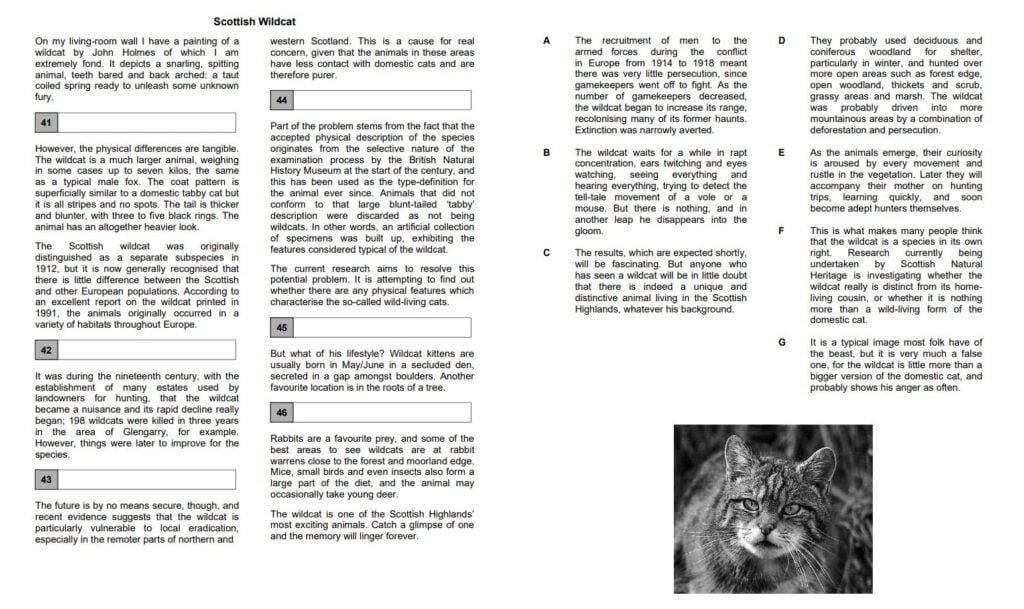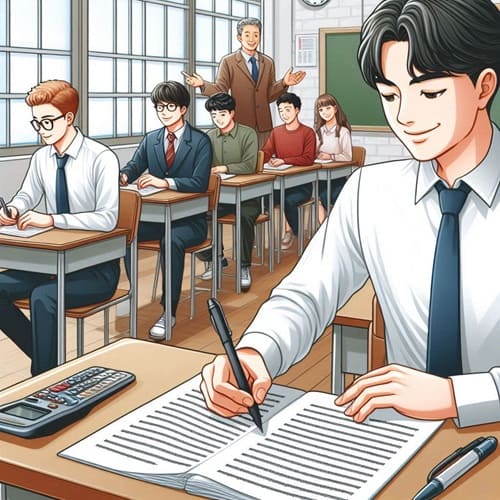Cambridge C1 (CAE): Reading and Use of English Part 7

Key Points
Gapped Text Task: CAE Reading Part 7 tests the ability to understand text structure, coherence, and the development of ideas by inserting paragraphs into gaps in a text.
Challenges: Key challenges include matching paragraphs to gaps, dealing with an extra paragraph, and managing time effectively during the exam.
Strategies for Success: Familiarize with the format, use logical reasoning to connect paragraphs, and practice extensively to improve skills for this part of the exam.
What you will find in this guide:
CAE Reading Part 7
CAE reading part 7 is a tricky one! So, if you preparing for the Cambridge C1 Advanced Exam (CAE), you need a detailed guide on how to ace the Reading Part 7, which is one of the most challenging parts of the exam. But fear not! In this guide, I will give you important tips and practice tests to put your newly acquired knowledge into practice and make sure you will do great at the exam. I will explain what CAE Reading Part 7 is, what skills it tests, and what strategies you can use to succeed in it. I will also provide a practice exercise with a walk through to help you get familiar with the format and the type of questions you will encounter. Finally, I will share some additional resources that you can use to further improve your reading skills and prepare for the exam. If you wish you to read about other parts of the Cambridge C1 Advanced (CAE), you can read my other guides by clicking here, and to read my guides to part 6 click here.
Part 7, The Structure
Having taken the CAE exam myself and prepared literally hundreds of students to take Cambridge C1 Advanced over the course of more than a decade, I can confidently say that I have unique understanding of the CAE structure and its challenges. So let’s talk about the structure.
According to Cambridge, part 7 of the reading and use of English paper is designed to test your understanding of complex texts. In this part, you need to match questions to the correct parts of a text. The reading and use of English, RUE, Part 7 is a gapped text task. You have to insert six paragraphs into six gaps in a text. The text is usually taken from a magazine, newspaper, or online article, and it can be about any topic. The task focuses on your ability to understand how a text is structured, how ideas, opinions and events are developed, and how the text is coherent and cohesive. You also have to understand the global meaning of the text and how each paragraph contributes to it. Here’s what this part looks like.

The Gapped Text task is designed to test several skills:
- Reading Comprehension: Understanding the main ideas and details of the text.
- Coherence and Cohesion: Recognizing how the text flows and how ideas are connected.
- Inference: Making logical connections that aren’t explicitly stated.
Here’s what you can expect:
- A text of around 650-800 words: This could be an article, an essay, or a report.
- Six gaps: Each gap represents a missing paragraph.
- Seven extra paragraphs: One of these paragraphs is not needed and serves as a distractor.
Sample Question
You are going to read an extract from a magazine article. Six paragraphs have been removed from the extract. Choose from the paragraphs A – G the one which fits each gap (41 – 46). There is one extra paragraph which you do not need to use.
Mark your answers on the separate answer sheet.
Scottish Wildcat
On my living-room wall I have a painting of a wildcat by John Holmes of which I am extremely fond. It depicts a snarling, spitting animal, teeth bared and back arched: a taut coiled spring ready to unleash some unknown fury.
41
However, the physical differences are tangible. The wildcat is a much larger animal, weighing in some cases up to seven kilos, the same as a typical male fox. The coat pattern is superficially similar to a domestic tabby cat but it is all stripes and no spots. The tail is thicker and blunter, with three to five black rings. The animal has an altogether heavier look.
The Scottish wildcat was originally distinguished as a separate subspecies in 1912, but it is now generally recognised that there is little difference between the Scottish and other European populations. According to an excellent report on the wildcat printed in 1991, the animals originally occurred in a variety of habitats throught Europe.
42
It was during the nineteenth century, with the establishment of many estates used by landowners for hunting, that the wildcat became a nuisance and its rapid decline really began; 198 wildcats were killed in three years in the area of Glengarry, for example. However, things were later to improve for the species.
43
The future is by no means secure, though, and recent evidence suggests that the wildcat is particularly vulnerable to local eradication, especially in the remoter parts of northern and western Scotland. This is a cause for real concern, given that the animals in these areas have less contact with domestic cats and are therefore purer.
44
Part of the problem stems from the fact that the accepted physical description of the species originates from the selective nature of the examination process by the British Natural History Museum at the start of the century, and this has been used as the type-definition for the animal ever since. Animals that did not conform to that large blunt-tailed ‘tabby’ description were discarded as not being wildcats. In other words, an artificial collection of specimens was built up, exhibiting the features considered typical of the wildcat.
The current research aims to resolve this potential problem. It is attempting to find out whether there are any physical features which characterise the so-called wild-living cats.
45
But what of his lifestyle? Wildcat kittens are usually born in May/June in a secluded den, secreted in a gap amongst boulders. Another favourite location is in the roots of a tree.
46
Rabbits are a favourite prey, and some of the best areas to see wildcats are at rabbit warrens close to the forest and moorland edge. Mice, small birds and even insects also form a large part of the diet, and the animal may occasionally take young deer.
The wildcat is one of the Scottish Highlands’ most exciting animals. Catch a glimpse of one and the memory will linger forever.
A The recruitment of men to the armed forces during the conflict in Europe from 1914 to 1918 meant there was very little persecution, since gamekeepers went off to fight. As the number of gamekeepers decreased, the wildcat began to increase its range, recolonising many of its former haunts. Extinction was narrowly averted.
B The wildcat waits for a while in rapt concentration, ears twitching and eyes watching, seeing everything and hearing everything, trying to detect the tell-tale movement of a vole or a mouse. But there is nothing, and in another leap he disappears into the gloom.
C The results, which are expected shortly, will be fascinating. But anyone who has seen a wildcat will be in little doubt that there is indeed a unique and distinctive animal living in the Scottish Highlands, whatever his background.
D They probably used deciduous and coniferous woodland for shelter, particularly in winter, and hunted over more open areas such as forest edge, open woodland, thickets and scrub, grassy areas and marsh. The wildcat was probably driven into more mountainous areas by a combination of deforestation and persecution.
E As the animals emerge, their curiosity is aroused by every movement and rustle in the vegetation. Later they will accompany their mother on hunting trips, learning quickly, and soon become adept hunters themselves.
F This is what makes many people think that the wildcat is a species in its own right. Research currently being undertaken by Scottish Natural Heritage is investigating whether the wildcat really is distinct from its home living cousin, or whether it is nothing more than a wild-living form of the domestic cat.
G It is a typical image most folk have of the beast, but it is very much a false one, for the wildcat is little more than a bigger version of the domestic cat.
Potential Challenges of Part 7
The Reading and Use of English (RUE) Part 7 of the Cambridge C1 Advanced Exam (FCE) can be challenging due to several factors:
1. Text Structure and Development: Understanding the text structure, the development of ideas, opinions, and events, as well as cohesion, coherence, and global meaning can be challenging1. The texts in Part 7 usually have a linear development, so understanding the storyline is crucial1.
2. Paragraph Matching: Deciding which paragraph fits into each gap can be difficult2. It requires careful examination of the text before and after the gap for clues such as linking words, reference words, grammar, and vocabulary2.
3. Extra Paragraph: In the exam, there will be one paragraph left that does not fit into the text2. Identifying this paragraph can be tricky.
4. Time Management: As one of the longest and most difficult tasks in the whole exam, managing time effectively while ensuring accuracy can be a challenge2.
To do well in RUE Part 7, you need to familiarize yourself with the format and the instructions. You have to read the text carefully and identify the main idea and the purpose of each paragraph. You also have to read the whole text first before you try to fill in the gaps, so that you can get a sense of the gist and predict what kind of information is missing. Then, you have to decide which paragraph to put in each gap by looking for clues such as linking words, reference words, grammar, and vocabulary that connect the paragraphs. You have to make sure that the paragraphs fit logically and coherently in the text.
Guide to Reading Part 7
Step 1:
Read the paragraph and identify the idea that paragraph is trying to express. Pay special attention to the end of the paragraph and the idea presented there because that idea will be continued in one of the answer choice. Try to see what the (end) of the paragraph is about and what information could go in the gap.
Step 2:
Read the answer choices, identify their main ideas and underline them. This helps you understand your answer choices. Try to see if you can find a matching idea to that of the paragraph you read earlier.
Step 3:
Use your logic and reasoning skills to determine which answer choice should be connected to which paragraph. Remember that there will be one more answer choice left.
Step 4:
Once you have the correct answer to one gap, read the completed paragraph, especially the end of the paragraph to see what the complete paragraph talks about and what information could go after that. If the idea at the end of the completed paragraph (that you just completed) matches the idea presented at the beginning of the next paragraph, you can be sure that your answer is correct.
Important Tips
Unfortunately, there is no 100% foolproof trick to guarantee easy completion of CAE Reading Part 7. It requires time, thought and a lot of practice. However, there are a few points that you should consider to ensure quicker and more accurate answers.
1. Understand References
Reference is the most important element of Advanced (CAE) Reading Part 7. The gapped text fits into place like a jigsaw puzzle and the reference words are the key to getting the pieces to fit. Reference words are anchors that connect one part of a text with another. They are often used to avoid repetition and to improve the flow of a text. Lets look at a few different types of reference words:
subject/object pronouns (I, he, she, it, they, him, her)
possessives (his, her, their)
relative pronouns (which, who, where)
determiners (this, that, those, these, such)
substitution of nouns with with one, ones
substitution of verb phrases with so
linking words (however, furthermore, too)
As you read through the missing paragraphs and the long text, you should underline or highlight every reference word.
2. Consider the Following Tips
- In order to be confident of a correct answer, you should always try to find two of the three elements listed above. A gut feeling can help you here, but it shouldn’t be the only reason you choose an answer.
- Work systematically through the textparagraph by paragraph.
- If you aren’t sure of a paragraph, work to eliminate wrong answersand write down which ones you eliminated. This way, when you come back to it later, you have less options to choose from.
- After choosing an answer, read throughthe preceding paragraph, the paragraph you chose and the following paragraphs in order. Do they sound correct together?
- Keep up the pace. There is a huge risk of spending too much time on this task, which will hurt you in other parts of the exam.
- Don’t simply choose a paragraph because it contains a similar word or words to the paragraph before or after. You will need to match paragraphs based on the development of ideas or opinions.
Practice Test
You are going to read an article about an advertising technique. Six paragraphs have been removed from the article. Choose from the paragraphs A – G the one which fits each gap (41-46). There is one extra paragraph which you do not need to use.
Windows of opportunity
Retail street theatre was all the rage in the 1920s. ‘Audiences’ would throng the pavement outside Selfridge’s store in London just to gawp at the display beyond acres of plate glass. As a show, it made any production of Chekhov seem action-packed by comparison. Yet Gordon Selfridge, who came to these shores from the US and opened on Oxford Street exactly 100 years ago, was at the cutting edge of what Dr Rebecca Scragg from the history of art department at Warwick University calls ‘a mini-revolution’ in the art of window dressing.
41
“As Britain struggled to regain economic stability after the war, the importance of the new mass commerce to the country’s recovery was recognised,” says Rebecca. “Finally understood was the need to use the display windows to full advantage as an advertising medium to attract trade. The new style of window dressing that came into its own after the armistice took inspiration from the theatre and the fine and decorative arts. It involved flamboyant design and drew huge crowds.”
42
In the course of her research, Scragg spent some time in the British Library studying the growing number of trade journals that sprang up between 1921 and 1924 to meet the market made up from this new breed of professional. “I saw a picture in one of them of the Annual General Meeting of the British Association of Display Men,” she says, “and there were only two women there”. The 1920s saw a big growth in major department stores in the main cities and they would all have had a budget for window dressing.
43
An elegant mannequin is positioned at the centre of a huge garland, sporting an off-the-shoulder number and an enormous headdress that might have been worn by an empress in ancient Egypt. At her feet are swathes of ruffled material and positioned around her any number of adornments.
44
Over eighty years on, and the economy is once again in recession. Retailers complain about falling sales. But are they doing enough to seduce the passing customer? Scragg thinks not. “There are many high street chains and independent shops whose windows are, by the standards of the 1920s, unimaginative,” she maintains. “They’re passed over for more profitable but often less aesthetically pleasing forms of advertising, such as the Internet.”
45
“I’m not making any claims that this is great or fine art” Scragg says. “My interest is in Britain finding new ways of creating visual expression.” Scragg is about to submit a paper on her research into the aesthetics of window dressing to one of the leading journals in her field.
46
So, although retail theatre may have been in its infancy, retail as leisure or therapy for a mass market was still a long way in the future.
A
Some of the photographic evidence unearthed by Scragg after her trawl through the trade journals is quite spectacular. One EJ Labussier, an employee of Selfridge’s, won the Drapers Record trophy for his imaginative use of organdie, a slightly stiff fabric that was particularly popular with the dressmakers of the day.
В
“Selfridge’s remains an exception,” she concedes, “even if it’s difficult today to imagine the store coming up with a spectacular Rococo setting to display something as mundane as a collection of white handkerchiefs.” No doubt it brought sighs, even gasps, from those with their noses almost pressed up against the window but could it really be taken too seriously?
C
Scragg describes herself as “a historian of art and visual culture with an interest in the reception of art”. “This interest in window displays evolved from my PhD on British art in the 1920s,” she says. “I started by looking at exhibitions in shops and that led on to the way that the shops themselves were moving into new forms of design.”
D
One of the illustrations she will include is a 1920s photograph of a bus proceeding towards Selfridge’s with an advertisement for ‘self-denial week’ on the side. For many of those in the crowds on the pavement, self-denial was a given. They couldn’t afford to spend.
E
The big department store continues to uphold the tradition of presenting lavish and eye-catching window displays today and uses the best artists and designers to create and dress them. Advances in technology have meant that the displays grow ever more spectacular.
F
“He was trying to aestheticise retailing,” she explains. “The Brits were so far behind the Americans, the French and the Germans in this respect that it was another decade before they fully realised its importance.”
G
“There was always a great concern for symmetry and harmony,” Scragg observes. “And a whole industry grew up around the stands and backdrops, the ironmongery and architecture, needed to display these things.” The displays were extravagant and bold, taking a great deal of time and imagination to perfect. The glamour attracted attention and lifted people’s spirits at a difficult time.
FAQ
You may find it difficult to decide which paragraph fits into which gap. Also the fact that there is one extra paragraph can make the process even more tricky. Managing time effectively while ensuring accuracy can also be a challenge.
Step 1: Identify the idea in the gapped paragraph. Step 2: read the options and see which paragraph is the most related to the idea you identified. Step 3: Connect the paragraphs together and read the completed paragraph carefully to see if it follows a logical progression of ideas.
References
- C1 Advanced exam format | Cambridge English
- How to do Advanced (CAE) Reading Part 7 – Breakout English
- CAE Reading Part 7 // Cambridge Advanced Reading & Use of English C1 (youtube.com)
- How to Do CAE Reading Part 7 (Gapped Text) (youtube.com)
- How To Pass C1 Advanced CAE Reading Paper Part 7 (youtube.com)
- Cambridge C1 Advanced (CAE): Reading and Use of English Part 7 – Teacher Phill
- Practice Test: Reading – Part 7 (Gapped Text) | C1 Advanced (CAE) | engxam.com
- Cambridge C1 Advanced (CAE): Reading and Use of English – Teacher Phill
- C1 (CAE) Reading & Use of English – Tips & Examples | engxam.com
Your experience
How was your experience preparing for Cambridge C1 Advanced (CAE) reading part 7? Describe your experience in the comment section below.







This part is really difficult. I get distracted easily and the reading is so long that when I am in the middle of it, I already forgot what I read before. I guess I have to practice a lot taking into account the steps (recommendations) given.
In my point of view, this part is super complicated, since there are many difficult words and part of them are not interesting topics that you would be interested in reading.Apart from that there is a paragraph that is not necessary but it is to confuse us and that also complicates me
It was difficult because the text is quite a bit extensive and we don’t have much time to do it. Furthermore, we have to pay special attention to the connectors since they could help us to do it that part.
From my point of view, it is one of the harddest part of the reading, I have some doubts and problems to complete it but, I”ll try by using the steps and the key information in order to get all the rigth answers !!
For me it’s not difficult at all but I think I lost many time doing this part because it’s a lot to read. 😞